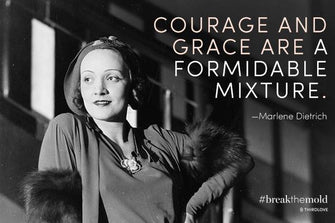Returns & exchanges free for 60 days for all U.S. orders. Please try on the bra to ensure a good fit, making sure to leave the original tags attached. We only accept underwear in unworn condition, with original tags, in its unopened original polybag. Items marked final sale are not eligible for return or exchange. If something’s not right, we can help. Our Fit Experts are available via live chat, or email to answer any questions you might have.
Read more3 Women Who Broke The Mold Through Fashion

From corsets to crop tops, women’s clothing has always held a paradoxical role: It’s a means of both replicating norms and shattering them. The pantsuit, for example—once dowdy and designed for a woman to blend in with her male counterparts—became a power symbol taking on extraordinary prestige and appeal as of late. Only in fashion can the same canvas be used as readily to fit in as it can to stand out.
As part of our #BreakTheMold series, we’re celebrating individual women and groups who took fashion into their own hands, using it as a tool for everything from self-expression to political change.

Here are three extraordinary examples:
Marlene Dietrich
"Glamour," Marlene Dietrich once said, "is assurance. It is a kind of knowing that you are all right in every way… and that, whatever the occasion or the situation, you are equal to it."
Dietrich’s place on the silver screen hit its peak in the 1930s and 40s, where she often played the femme fatale or androgynous roles—mirroring her personal life in many ways. Openly defying sexual norms was part and parcel of Dietrich’s image, as she regularly donned pants and masculine fashions both on- and off-screen. Rumored to have had numerous lovers, including affairs with women, her sexuality was unbound by convention.
"She has sex but no positive gender,” critic Kenneth Tynan wrote of Dietrich. “Her masculinity appeals to women and her sexuality to men." Her look—the Dietrich silhouette—was instrumental in popularizing trousers and menswear for women. It continues to inspire fashion, with collections by contemporary designers Peter Som and Jason Wu drawing on the actress’s iconic image.
Amelia Bloomer

Source: Wikimedia Commons.
In a time of crinolines, bustles and tight-laced corsets, Amelia Bloomer wanted—among other things—a little breathing room. Born in 1818 and an active advocate for women's rights, Bloomer recognized that the physical restrictions of the era’s clothing were both impractical and socially stifling. How could a woman who could hardly move go about her day’s tasks, much less fight for the right to vote or work for a wage outside the home?
Seeking an alternative, she popularized “bloomers,” loose-fitting pants cinched at the ankle, worn with a loose top and knee-length skirt. Although she didn’t invent the garment, it bears her name thanks to her strong advocacy for dress reform. She said: "As soon as it became known that I was wearing the new dress, letters came pouring in upon me by the hundreds from women all over the country making inquiries about the dress and asking for patterns—showing how ready and anxious women were to throw off the burden of long, heavy skirts."
Although a woman in pants would hardly draw a second glance today, the outfit was so revolutionary at the time that it prompted ridicule and scorn. Still, Bloomer carried on her feminist work until her death in 1894—including publishing The Lily, a newspaper for women, and advocating for women’s suffrage—extending her impact well beyond her namesake fashion.
Michelle Obama

Source: Wikimedia Commons.
Among the many ways Michelle Obama has made history, her iconic style is certainly one of them. As first lady, she embodied a look that was polished yet accessible, stylish yet substantive. Moreover, her choices in the designers she wore were intentionally broad and inclusive—a global set of designers at varying stages in their careers.
Rather than understanding the first lady wardrobe as a kind of uniform, Michelle Obama used it as a tool to express herself and send a message. "In the beginning, designers used the phrase 'first ladyish' to describe a certain traditional look,” said her stylist, Meredith Koop, “we really had to break that mold."
Her choice of bare arms drew criticism, highlighting her rejection of outdated conventions (and her enviably toned biceps). When she stated on the Tonight Show that her outfit was from J. Crew, quipping “You can get some good stuff online!” she was simultaneously the most important woman in America and your best friend.
While a first lady’s choice of dress may seem somewhat superficial relative to the political agenda, the fact that it’s so highly visible and comment-able can make it all the more powerful at sending a message. Through her actions or through her dress, Michelle Obama was able to enter the cultural conversation at many levels, from advocacy to attire.
It’s been said that style is a way to say who you are without words. These women show that it’s also a way to say what you stand for, a way to show that change can be worn. Those are messages worth remembering next time you’re putting on a pair of pants—or running for office.
This post is part of our #BreakTheMold series, where we celebrate the lives and work of trailblazing women. Check out the rest of the series here.
Tags: